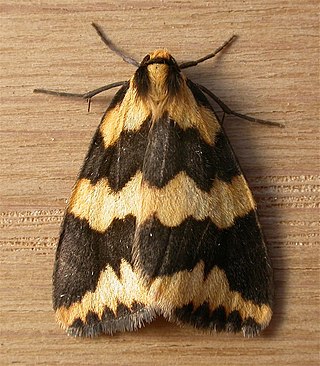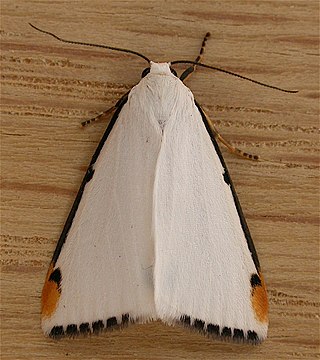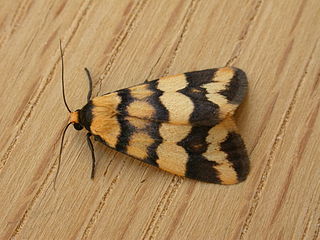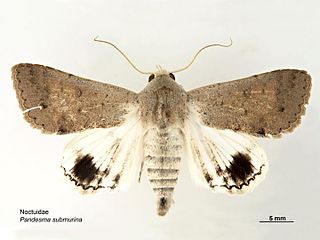
Termessa diplographa is a moth of the subfamily Arctiinae first described by Alfred Jefferis Turner in 1899. It is found in Eastern Australia, often inhabiting forested and open woodlands, as well as heathland habitats. As a lichen moth, the larvae of Termessa diplographa likely feed on lichens that grow on tree trunks.

Termessa shepherdi, the shepherd's footman, is a moth of the subfamily Arctiinae. The species was first described by Newman in 1856. It is found in the Australian states of New South Wales, Victoria and Tasmania.

Termessa is a genus of moths in the subfamily Arctiinae The genus was described by Newman in 1856.

Daddala is a genus of moths in the family Erebidae erected by Francis Walker in 1865. The genus is exclusively Indo-Australian, extending from the Indian Subregion to New Guinea.

Arctornis is a genus of tussock moths in the family Erebidae, and the sole member of the tribe Arctornithini. The genus was erected by Ernst Friedrich Germar in 1810.
Amata aperta is a species of moth of the family Erebidae first described by Francis Walker in 1865. It is found in Australia and New Guinea.

Termessa zonophanes, the double yellow-patched footman, is a moth of the subfamily Arctiinae. The species was first described by Edward Meyrick in 1888. It is known from the Australian Capital Territory, New South Wales, Queensland and Victoria.

Zalissa catocalina is a moth of the family Noctuidae first described by Francis Walker in 1865. It is found in Papua New Guinea and Australia. In Australia, it is found in or near rainforests in eastern Australia as far south as northern New South Wales.

Pandesma submurina, the pale migrant, is a moth of the family Erebidae first described by Francis Walker in 1865. It is found in Australia in New South Wales, the Northern Territory, Queensland and Western Australia.
Spodoptera apertura is a moth of the family Noctuidae first described by Francis Walker in 1865. It is known from China, India, Sri Lanka, South Africa, Madagascar and Australia.
Termessa catocalina is a moth in the subfamily Arctiinae. It was described by Francis Walker in 1865. It is found in Australia, where it has been recorded from New South Wales and Victoria.
Termessa congrua is a moth in the subfamily Arctiinae. It was described by Francis Walker in 1865. It is found in Australia, where it has been recorded from New South Wales and Queensland.
Termessa conographa is a moth in the subfamily Arctiinae. It was described by Edward Meyrick in 1886. It is found in Australia, where it has been recorded from New South Wales and Queensland.
Termessa discrepans is a moth in the subfamily Arctiinae. It was described by Francis Walker in 1865. It is found in Australia, where it has been recorded from the Australian Capital Territory, New South Wales, Queensland and Victoria.
Termessa gratiosa is a moth in the subfamily Arctiinae. It was described by Francis Walker in 1865. It is found in Australia, where it has been recorded from the Australian Capital Territory, New South Wales, Queensland and Victoria.
Termessa laeta is a moth in the subfamily Arctiinae. It was described by Francis Walker in 1856. It is found in Australia, where it has been recorded from the Australian Capital Territory, New South Wales, Queensland, South Australia, Victoria and Western Australia.
Termessa orthocrossa is a moth in the subfamily Arctiinae. It was described by Alfred Jefferis Turner in 1922. It is found in Australia, where it has been recorded from New South Wales and Queensland.
Acantholipes trajecta is a species of moth in the family Erebidae first described by Francis Walker in 1865. It is found in South Africa, India, Sri Lanka, and Australia, where it has been recorded from Western Australia, the Northern Territory and Queensland.








